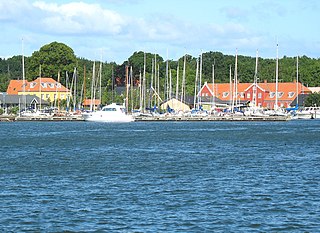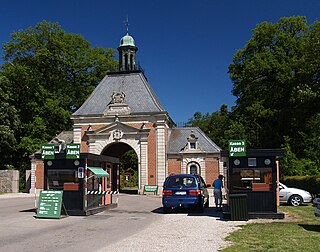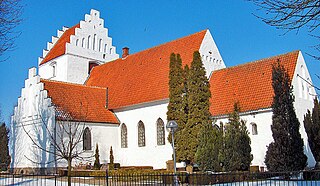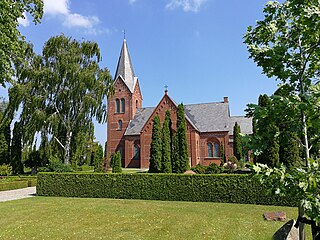
Maribo is a town in Lolland Municipality in Region Sjælland on the island of Lolland in south Denmark. It was the municipal seat of the former Maribo Municipality, until 1 January 2007, and then it became the seat of the current Lolland Municipality.

Nakskov is a market town on the island of Lolland in south Denmark. The town has a population of 12,445 and is the largest town on the island of Lolland. It is located in Lolland municipality in Region Sjælland.

Rødby is a town, with a population of 1,957, located on the island of Lolland in Denmark. It was the seat of the former Rødby Municipality.

Sakskøbing, previously spelled Sakskjøbing, is a town on the island of Lolland in south Denmark. It has a population of 4,556. Until 1 January 2007 it was the seat of the former Sakskøbing Municipality, and is now situated in Guldborgsund Municipality in Region Sjælland.
Knud Olsen was a Danish builder and designer of boats, who designed one of the most popular sailing dinghies in use over the past 50 years, the OK Dinghy, which became an ISAF International Class in 1974.

Lolland Municipality is a kommune on the island of Lolland in the Region Sjælland of Denmark. According to Municipal And Regional Key Figures (www.noegletal.dk) it covers a total area of 885.40 km2 and has a population of 39,632. The western part of Guldborgsund Municipality, the southernmost in Denmark, occupies the eastern part of the island (Østlolland).

Port of Kolkata or Kolkata Port, officially known as Syama Prasad Mookerjee Port, is the only riverine major port in India, in the city of Kolkata, West Bengal, around 203 kilometres (126 mi) from the sea. It is the oldest operating port in India and was constructed by the British East India Company. Kolkata is a freshwater port with no variation in salinity. The port has two distinct dock systems – Kolkata Dock at Kolkata and a deep water dock at Haldia Dock Complex, Haldia.
The Port of Montreal is a cruise and transshipment point. It is located on the St. Lawrence River in Montreal, Québec, Canada. The port operates as an international container port. It services Toronto, the rest of Central Canada, the Midwestern United States, and the Northeastern United States. Though found on the Saint Lawrence Seaway, it is some 1,600 miles (2,600 km) inland from the Atlantic Ocean and it is on the shortest direct route between the North American Midwest and Europe or the Mediterranean.

Wells Harbour is located in the town of Wells-next-the-Sea in the county of Norfolk, England. The harbour is 21 miles west of Cromer, 34.8 miles north of Norwich and 123 miles north of London. The harbour lies north of the A149 between King's Lynn and Great Yarmouth. The nearest railway station is now at Sheringham for the Bittern Line which runs between Sheringham, Cromer and Norwich. The nearest airport is Norwich International Airport.

Lolland is the fourth largest island of Denmark, with an area of 1,243 km2 (480 sq mi). Located in the Kattegat, Belts and Sund area, it is part of Region Sjælland. As of 1 January 2022, it has 57,618 inhabitants. Lolland is closely connected to the island of Falster to its east. The locality of Sundby forms a cross-island urban area with Nykøbing Falster, the largest conurbation partially on Lolland. The most populated settlement on Lolland proper is Nakskov.

Maribo Cathedral is a Lutheran cathedral church built in the Gothic style in Maribo on the island of Lolland in the southeast of Denmark. It was originally part of Maribo Abbey which was founded in the early 15th century. The chancel, the oldest section of the cathedral, probably dates from 1416. The plan of the church is unusual in that the chancel is at the west end of the building rather than the east as a result of the design instructions left by Saint Bridget.

Guldborg is a fishing village spanning the islands of Falster and Lolland in Denmark. It belongs to Guldborgsund Municipality, in Region Zealand. In 2024 the village had a population of 515, with about 500 living on the Lolland side. The village is located at the narrowest point between the two islands where Guldborg Bridge crosses Guldborgsund Sound.

Knuthenborg Safaripark is a safari park on the island of Lolland in the southeast of Denmark. It is located 5 km (3.1 mi) to the north of Maribo, near Bandholm. It is one of Lolland's major tourist attractions with over 300,000 visitors annually, and is the largest safari park in northern Europe. Among others, it houses a drive-through safari park, a monkey forest, large enclosures for Siberian tigers and African bush elephants, the Dinosaur Forest with full-scale models, the Museum of Evolution with fossils of dinosaurs and other prehistoric animals, an arboretum, and the largest nature playground in Denmark. Knuthenborg covers a total of 660 hectares, including the 400-hectare (990-acre) Safaripark. The park is viewable on Google Street View.

Knuthenborg is a manor house located 6 km (3.7 mi) north of Maribo on the Danish island of Lolland. Originally known as Årsmarke, it was first mentioned in 1372. Today's building was completed in 1866 to a design by Henrik Steffens Sibbern. The medieval manor of Årsmarke, with its more than 300 years of history, was once Denmark's largest private estate; it is now part of Knuthenborg Safaripark. The exotic shrubs and trees planted during the era of the Counts of Knuthenborg are situated on the grounds.

Nørreballe is a village on the Danish island of Lolland. With a population of 476, it is located 6 km (3.7 mi) northwest of Maribo. The village of Østofte with its 14th-century Østofte Church is now part of Nørreballe.

Østofte Church, located in the village of Nørreballe on the Danish island of Lolland, was built in the 14th century. The Romanesque apse, chancel and nave formed the original building while the tower and porch were added in the Late-Gothic period and the north wing was completed in 1656.

Hunseby is a village located some 3 km (1.9 mi) north of Maribo on the Danish island of Lolland. It belongs to Lolland Municipality in Region Sjælland. As of 2024, it has a population of 399.

Bandholm Church is a Church of Denmark parish church located in the harbor village of Bandholm some 8 km (5.0 mi) north of Maribo on the Danish island of Lolland. It was built in 1874 by Henrik Steffens Sibbern to a cruciform plan in the Romanesque Revival style. Built of red brick, it consists of a chancel, a nave and a tower with a conical spire.

Højbygaard Sugar Factory was built in 1872–74 at Holeby on Lolland in southeastern Denmark. It was one of the first modern sugar factories built for the country's emerging sugar beet industry. It was taken over by De Danske Sukkerfabrikker in 1877 and operated until 1959. The buildings were then acquired by De Forenede Papirfabrikker and operated as a paper mill under the name Højbygaard Papirfabrik from 1960 to 1993.

Nakskov railway station is a railway station serving the town of Nakskov on the island of Lolland, Denmark.























